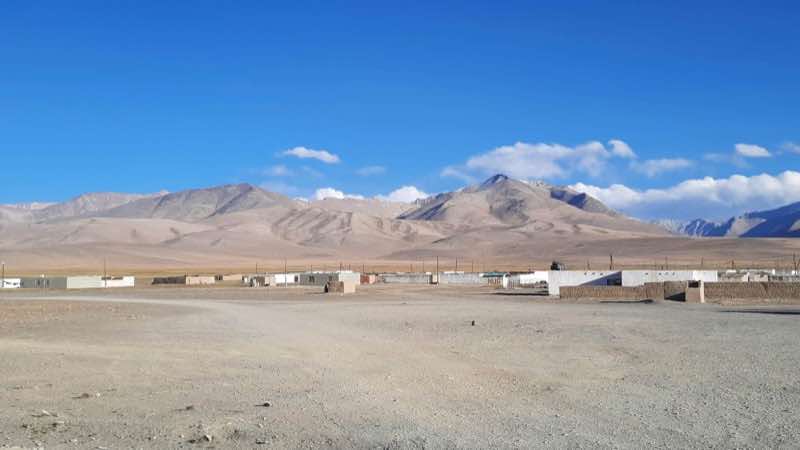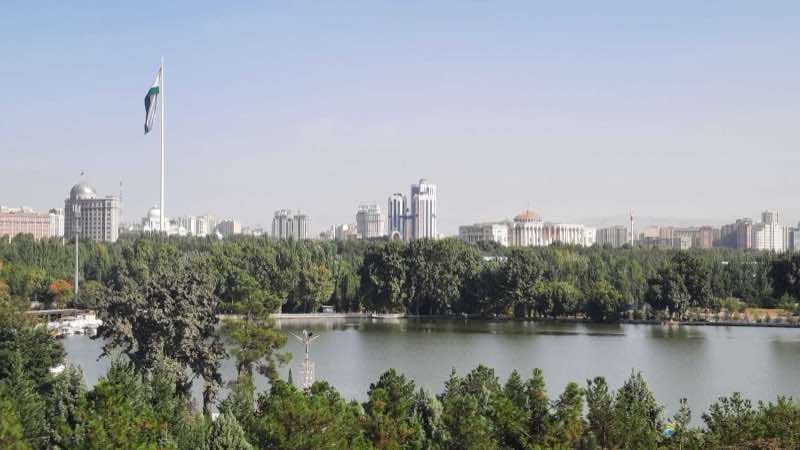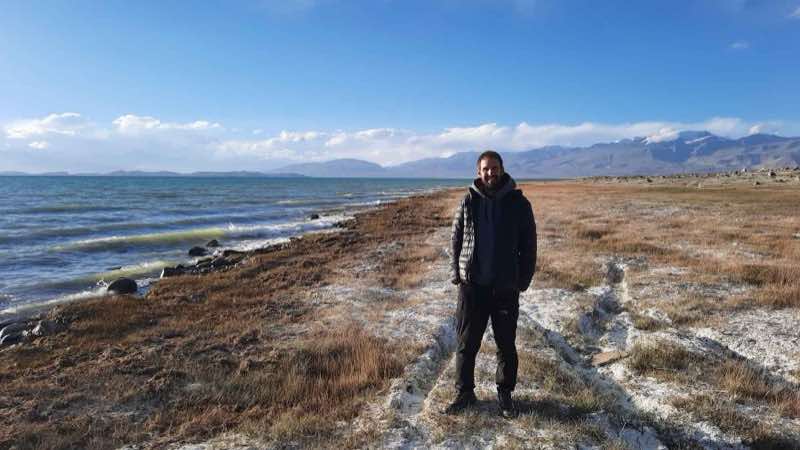Pamir Highway and Wakhan Valley: My Solo Adventure Through Tajikistan
I was standing on a remote road in Kyrgyzstan, near Sary-Tash and not far from the Tajik border, waiting for any passing car to take me across one of the most isolated frontiers in Central Asia. The wind carried dust across the empty valley, and hours went by without seeing a single vehicle. It felt like the edge of the world, and in a way, it was.
What I didn’t know at that moment was that this was just the beginning of my journey along the legendary Pamir Highway, a route that would take me through high-altitude mountain passes, remote villages, and some of the most breathtaking landscapes I’d ever seen. It wasn’t going to be easy, but that was the challenge I decided to take on.


author at Karakul Lake
Setting My Goal: Crossing the Pamir Highway and Wakhan Valley Independently
I had spent the last month traveling around Kyrgyzstan, sleeping in yurts and hiking through wild mountains, such as the famous Ala-Kul Lake trek.
Now, I was ready for something different, to cross into Tajikistan and take on the Pamir Highway and the Wakhan Valley entirely on my own. No tour, no fixed plans, just the road, my backpack, and whoever I’d meet along the way. My goal was simple, at least on paper: cross the remote Kyzyl Art Pass, a high-altitude border between Kyrgyzstan and Tajikistan that sits at over 4,200 meters, and then travel through some of the most isolated villages I’d ever seen.
From there, I wanted to reach the Wakhan Valley, follow the Panj river that separates Tajikistan from Afghanistan, connect with the people who live in these rugged lands, and eventually make my way to Dushanbe, the Tajik capital.
What Is the Pamir Highway and the Wakhan Valley?
The Pamir Highway, officially known as the M41, is one of the world’s highest and most legendary roads. Stretching over 1,200 kilometers from Osh in Kyrgyzstan to Dushanbe in Tajikistan, it crosses the Pamir Mountains, often called the “Roof of the World.” Built during Soviet times to connect remote regions, today it attracts adventurous travelers eager to experience its wild landscapes, dizzying mountain passes, and isolated villages.
Running parallel to part of the highway lies the Wakhan Valley, a breathtaking corridor that separates Tajikistan from Afghanistan, divided only by the Panj River. The valley has been a crossroads of cultures for centuries, once part of the Silk Road, and it remains one of the most remote inhabited areas in Central Asia. Travelers come here for its raw beauty, ancient fortresses, and the warm hospitality of the Pamiri people who live amid towering peaks and green valleys.
Preparing for the Crossing
I had done my homework. I knew that only tourist vehicles could cross from Kyrgyzstan; locals are not allowed to use that border. I also learned that I’d need two permits: one to show at the Kyrgyz checkpoint, and the GBAO permit to access the restricted region of Tajikistan.
By that point, I had everything ready, paperwork, food, and determination, to start my solo Pamir Highway adventure. All I needed now was a car with an empty seat and a driver kind enough to take me across one of the most remote borders in Central Asia.


Crossing the border with the Belgium group
Crossing the Border
After a few long hours standing by the roadside, a car finally slowed down. It was a group of Belgian travelers who had rented a 4×4 in Osh and were planning to return it in Dushanbe. They had one empty seat. They asked if I had all the permits, because if I couldn’t move forward, they wouldn’t come back. And if I could chip in for the fuel. It sounded more than fair. I was already happy that they stopped, so I didn’t hesitate.
We soon began the ascent toward the Kyzyl Art Pass, which at 4,280 meters is one of the most spectacular border crossings I have ever seen.
Between the Kyrgyz and Tajik checkpoints lies a stretch of barren wilderness known as “no man’s land“. It’s 20 kilometers of pure desolation, high winds, and total isolation. If something happens there, no one’s coming to help.
First Stop: Karakul
After hours of driving through endless mountain roads and crossing another high pass, we finally reached our first stop, Karakul, a forgotten village beside a massive lake of the same name. The place felt like a ghost town. We arrived in the afternoon, and the streets were completely empty except for a few kids wrestling in the dust. Everything was dry, silent, and windblown.
We found a small guesthouse open and decided to stay there for the night. Over dinner, we met a local guide traveling with a couple of tourists heading toward the border. It’s an irrelevant detail now, but it will become more important the next day.
There isn’t much to do in Karakul, just walk along the lake’s edge, watch the light change over the barren landscape, and take in the feeling of being completely isolated from the rest of the world.
Karakul Lake
Back on my own
The next morning, the Belgians decided to continue their journey on their own. They told me it was a trip for friends and they wanted to keep it that way. It made sense, so I thanked them again for the trip and wished them luck.
Once more, I found myself alone, standing by the dusty road outside Karakul, waiting to see if any car would stop and take me toward Murghab, the capital of this remote region. There weren’t many options, as I said before; only tourist vehicles are allowed to cross from the Kyrgyz border in this direction. After a few hours of waiting, I spotted a truck approaching.
It turned out to be the same local guide I had met the night before. He had just dropped off his clients at the border and was heading back to Murghab. They had plenty of space and kindly offered me a ride, refusing any payment. Once again, luck, or fate, seemed to be on my side.
Arrival in Murghab
The road to Murghab was long and harsh, endless mountains, dust, and silence. But as we descended toward the town, it felt like a return to some kind of civilization. Murghab, though called a city, feels more like a large, scattered village surrounded by barren hills.
The first thing I noticed was the wind. It never stops. It whips across the town, carrying dust that fills your eyes, your mouth, everything. At times, it was hard to even breathe.


Murghab Center
The “center” of Murghab is unlike anything I’d ever seen, a row of shipping containers converted into shops. Inside them, you’ll find small groceries, fruit stalls, hardware stores, and even a place selling used clothes.
There are also a few guesthouses around town and, surprisingly, a small office of a mobile company selling SIM cards. I bought one, but the signal barely worked, just enough to remind me how far from the world I really was.
Heading Toward the Wakhan Valley
My goal for the next day was to reach Langar, the first village that marks the beginning of the legendary Wakhan Valley. Technically, the Pamir Highway continues straight from Murghab toward Khorog, the capital of the region, but that route is rather monotonous. Most travelers take the scenic detour through the Wakhan, a valley that runs right along the Afghan border, separated only by the Panj River.
Getting there, however, is far from easy. The road is long, winding, and mostly gravel in poor condition. The few vehicles that pass, mostly trucks from China, continue straight on the main Pamir route, never turning toward the valley. A few shared taxis make the trip, but they’re expensive.
I decided to hitchhike again, waiting at the edge of town under the blazing sun. This time, luck wasn’t on my side. After hours with no success, a local man approached me and, with very limited English, told me his family was driving to Langar and had a spare seat, but for USD 20. Gas is expensive here, so it was fair. I agreed, and soon I was squeezed into a jeep with six people. No one spoke English, but they showed their kindness in other ways, passing me food, smiling, and making sure I was comfortable.


Alichur
We made our first stop in a tiny settlement called Alichur, a cluster of maybe twenty scattered houses in the middle of nowhere. The altitude here is around 3,900 meters, and the climate gives no mercy: thin air, biting wind, and an emptiness that stretches to the horizon. From this point, the road begins to veer off toward the Wakhan Valley.
The jeep we were traveling in wasn’t in great shape. The gears kept jamming, and more than once we had to get out and push it to start again. What should’ve been a 7–8 hour journey turned into a grueling 12-hour ordeal. We finally reached Langar well past midnight, the village cloaked in total darkness.


Family house where I slept in Langar
I had nowhere to stay, but the family invited me to join them, first for dinner, then to spend the night at their home. They fed me, gave me a sofa, and a few thick blankets. That night, somewhere deep in the Pamirs, I realized one thing clearly: Tajik people are among the most hospitable I’ve ever met.
Langar, the first village in the Wakhan Valley
The next morning, I told the family I would move to a guesthouse, but they wouldn’t let me go. After so much insistence, I decided to stay another night with them, though I insisted on paying something for their kindness. They didn’t want to accept it, but it made me feel better to contribute.
With daylight, I finally went out to explore the area. The landscape had completely changed from the barren mountains of the previous days. The Wakhan Valley was green, alive, with small patches of crops, a few trees, and a river that marked the border with Afghanistan.


Langar in Wakhan Valley
The village itself felt vibrant, full of children running around, often following me curiously. For them, seeing a lone foreigner wandering through their streets was something rare.
Langar has a few petroglyphs scattered on the rocks above town, though many have been vandalized over time. Still, what I enjoyed most was walking freely through the surrounding villages, Hisor and Zong, just a few kilometers away. People greeted me warmly, kids tried to practice a few words of English, and the scenery was simply stunning.


Zangibor Fortress in Hisor
On one of those walks, I stumbled upon the ruins of an old fortress, once used to guard the trade routes that passed through this remote valley, a silent witness to the centuries of history carved into the Pamirs.
Through the Heart of the Wakhan Valley
The next day, it was time to continue my journey through the valley. I said goodbye to the family, deeply grateful for their kindness, and went back to the main road to try my luck hitchhiking again. In this region, it’s a bit easier to get a ride; besides tour cars (which are often full), many locals travel between villages. Still, a few of them stopped only to ask for quite a bit of money for short distances, something not uncommon here, as they often take advantage of travelers passing through.
After waiting a while, a camper van stopped. Behind the wheel was Tony, a German traveler who had bought the vehicle in Bishkek and was driving it all the way back to Germany after exploring Central Asia. He was traveling solo and heading in the same direction as me, so he offered me a ride, no payment needed.


Yamchun Fort
Along the way, we stopped at Yamchun Fort, another ancient fortress, this one in much better condition and dramatically perched on a hill overlooking the Wakhan Valley. The view from up there was absolutely breathtaking, a must-stop for anyone traveling this route.
Later that day, we continued to a small village called Darshai, where the first person we asked about accommodation immediately invited us to stay at his home, offering dinner and breakfast in exchange for a small contribution.


Rushon Family
A Taste of Afghan Culture in Ishkashim
The woman from the family who hosted us was incredibly kind and funny. Even without speaking much English, she kept joking about our communication struggles. Even today, I still receive short messages from her asking how I am, which reminds me of the warmth and hospitality that define these people.


Afghan Market
The next day, Tony and I continued our journey to Ishkashim, one of the larger towns in the Wakhan Valley. It has an attraction that stands out: once a week, an Afghan Market sets up on an island in the river where Afghans come to sell their goods: clothes, carpets, stones, and vegetables.
It’s like a fair where locals and tourists alike can browse and experience a slice of Afghan culture without crossing the border.
Many spoke good English and asked where I was from, about my studies, or if I was married. Some even asked to take photos with me to receive later. Their friendliness was remarkable.


Khorog
Reaching Khorog – A first approach to real civilization
After buying a few souvenirs and sharing tea with some Afghans at the market, we continued toward Khorog, the capital of the region.
I instantly loved this city. For the first time in days, it truly felt like being back in civilization. There were buses, traffic lights, museums, plenty of restaurants and bars, and green parks everywhere. It felt really alive.
For many travelers who do the route in the opposite direction from mine, Khorog is the starting point of their journey through the Wakhan Valley. That’s why the city had noticeably more tourists than I’d seen in previous days.


Jizev Valley
A short hike into Jizev Valley
The next day, Tony, a French girl who had joined us, and I went to Rushon, a small town not far from Khorog that served as our base for a short hike into Jizev Valley. The trail led us into a quiet, remote valley dotted with a few local houses and a beautiful lake that perfectly mirrored the surrounding mountains.
It wasn’t the most spectacular hike I’ve done, but it offered a chance to stretch our legs, breathe some mountain air, and see a calmer side of life in the Pamirs.
The Final Stretch to Dushanbe
The last day of my Pamir journey had arrived. All that was left was reaching Dushanbe, the capital of Tajikistan. Tony and the French girl had different plans, so once again, I was on my own.
From Khorog, the road has more truck traffic heading toward the capital, but riding in one of those would’ve taken forever. The distance between Rushon and Dushanbe is 530 km, but the road that everyone warned me about was in terrible shape.
So I decided to join a shared taxi with locals for about USD 40. What was supposed to be a 14–16 hour trip turned into a grueling 21-hour ride. We left around 9 a.m. and didn’t reach Dushanbe until 6 a.m. the next day. The road was full of delays, with long stops where construction crews blocked the way for hours. Packed shoulder to shoulder in the car, it was a journey I won’t forget, mostly because of how much I suffered through it.


Dushanbe
Arrival in Dushanbe and finishing the journey
Finally arriving in Dushanbe was truly rewarding. It wasn’t just that I was completing this epic journey through one of the most remote regions on Earth, but also because the city itself truly amazed me. It felt as if I had arrived in another country altogether, modern, cosmopolitan, and full of life. The architecture blended Islamic elegance with Soviet grandeur, creating a unique skyline that I hadn’t seen anywhere else in Central Asia except Almaty, Kazakhstan.
I spent the following days resting and exploring: the impressive National Museum of Tajikistan, the ornate Navruz Palace, and the broad boulevards lined with parks and fountains. After weeks of dust, mountains, and rugged roads, Dushanbe was both a relief and a revelation, a city I hadn’t expected much from, yet one that gave me so much.
Final Thoughts
Before starting this journey, I wasn’t sure if I could actually make it. Everything about the Pamir felt distant and uncertain; there’s no public transport, tours are expensive, and the terrain is unforgiving.
The Wakhan Valley was a reward amidst so much desolation on the roof of the world; it is like an oasis surrounded by rugged mountains.
But what I discovered along the way was something far more powerful: the kindness of strangers. From foreign travelers who gave me rides to local families who opened their homes, every step forward was made possible by people’s generosity.





